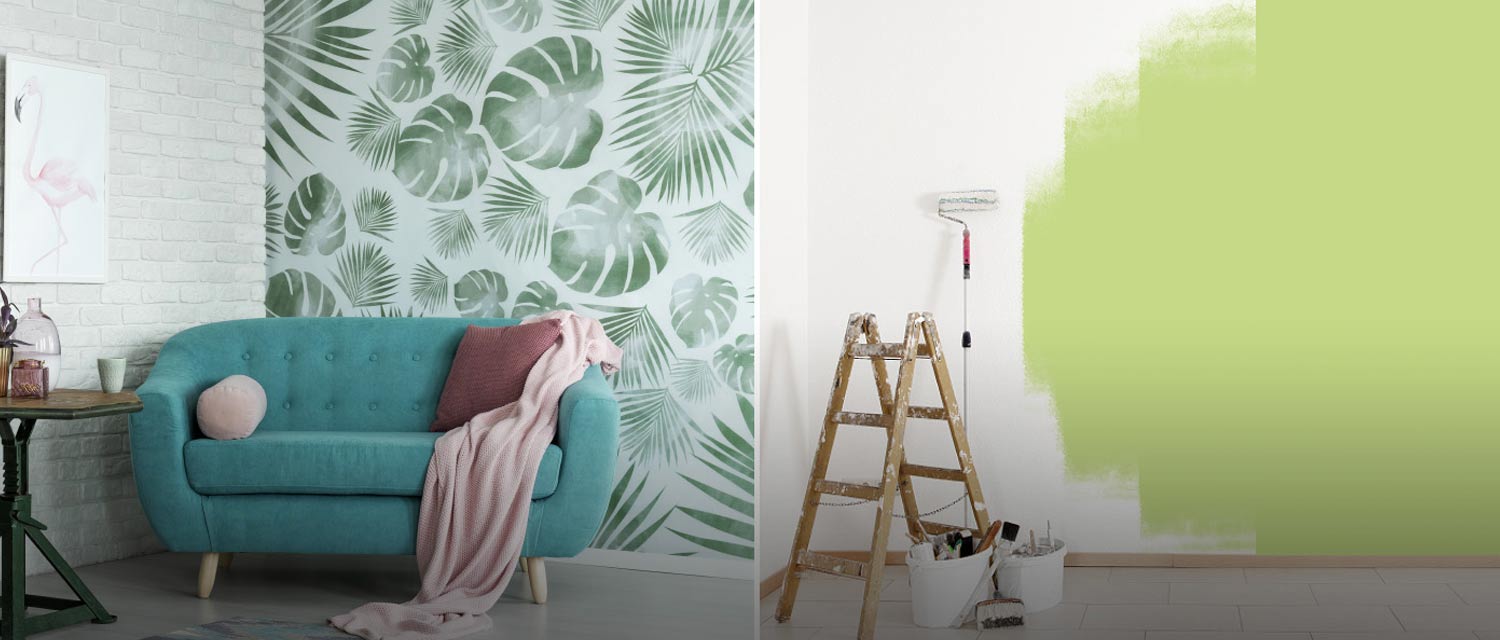You must paint or install wallpaper in the areas of your home that you want to transform in look. For people who've decided to buy a new house or have been dwelling in their homes for a long term, converting the appearance of the walls is a suitable way to adjust the house's general appearance.
However, a question arises about what option could be more suitable in your case. Wallpaper and paint have their precise advantages and disadvantages, making choosing among them viable depending on the room, price range, and other elements. Here, we’ll take you through all the records and critical concerns you’ll want to consider if you need to make the proper decision about your property’s painting and wallpapering.
Durability: Wallpaper Wins
In terms of long life, wallpaper has a clear victory. If installed correctly and managed correctly, wallpaper can last for about ten to fifteen years. This implies that touch-ups would be less frequent and replacements would be done after longer intervals. On the other hand, paint needs more maintenance work to be done on the surface to maintain its bright and glamorous look. You may have to use a new layer to your walls every three to five years, especially if there’s the experience of children and pets or the colour fades due to general wear and tear.
Wallpaper is a good option if you want eye-catching and long-lasting decor for the chosen room since it does not require constant care. But if you change the decor more often, painted walls can be more appropriate, even if they need to be repainted more often.
Cost: Wallpaper is More Cost-Effective Over Time
The cost of wallpaper at the beginning is higher than paint since you may have to use quality wallpaper or hire someone to put it on the wall. Putting up wallpaper can cost between $250 and $1,000, while the paint costs can go for about $200 and $700 per room.
But here's where wallpaper has the upper hand: its long life span. You will use more cash initially but will not have to redo the walls as you’d need to repaint them. In the long run, this could help one. Reduce expenses. If you are likely to spend several years in your home and prefer a permanent solution, then wallpaper could be an expense.
DIY-Friendliness: Paint Takes the Lead
For a do-it-yourself, painting is the way to move. Painting is usually a small-scale venture that does not require professional assistance from an artist. Preparing the walls, choosing the paint, and then painting them with the help of a broom or roller are carried out in this process. However, it is time-consuming and does not require expert skills or knowledge.
Wallpapering can prove to be challenging for the installation process. It demands accurate measurements, correct positioning of patterns, and good coordination to ensure no bubbles or creases. People hiring a professional wallpapering expert for this sort of work might increase the prices. If you have decided to paint your walls, you don’t need to allow the wallpaper to move; you are in for a steep studying curve.
Design Variety: It’s a Tie
Wallpaper and paint are versatile and available in various designs and thus are facets of this category. Wallpaper is available in numerous designs and offers an exciting way to change wall appearance or add a touch of sophistication to the interior. They can range from loud and clear to almost invisible – the choice is vast.
Paint, however, allows for unmatched customization. With other paints, you can blend various shades and tones to achieve your desired colour. Also, paint offers possibilities for additional techniques such as stencilling, colour blocking, or even painting a mural. Paint allows you to make the design as unique as possible since no other material can be painted perfectly. But remember that intricate paint designs may take considerable time, and it is always better to get the help of painting specialists in this sphere.
Resale Value: Paint Has the Edge
It isn't always easy to treat stains and mould but with the right solution, blinds may be cleaned and made to appear as desirable as new.
Regarding resell value, it is often paint that comes out on top. Applying a fresh coat of light colour on the walls can make a home more attractive to buyers. Logically, it is easier for buyers to visualize themselves in a space with smooth and plain wall painting. Wallpaper, on the other hand, can be great if done well; otherwise, it could leave a lot to be desired. While some buyers may love your wallpaper choice, others might see it as something they need to remove, which could be a deal-breaker.
Paint is likely the safer bet if you plan to sell your home soon. Some buyers would appreciate the wallpaper you selected, while others may consider that as something they have to change, which won’t work for them. If you are considering reselling your home, paint is undoubtedly safe. It’s less controversial and appeals to a broader audience, meaning more consumers are driven to your door via the web and possibly more value to your home.
Best for Bathrooms and Kitchens: Paint
Houses with high humidity, or rooms such as the bathroom or the kitchen, are better off with paint. Humidity does not agree with wallpaper at all. It may come to the point when the adhesive is compromised, resulting in the wallpapers peeling off. Another downside is that dampness can occur at the back of the wallpaper and wallpaper, resulting in mould formation – an intense difficulty on partitions that may pose fitness dangers.
Moisture-resistant paints are more able to deal with the impacts of humidity than general paints. Various finishes are supposed to be used inside the bathroom and the kitchen. These paints are designed to hold off moisture and mould, making them a more appropriate option for those areas.
Ease of Replacement: Paint is Simpler
But if you are the type of person who loves to alter the look of your house now and then, paint is more convenient. Improving a room is equally simple—drape new paint over the old paint. If you convert from a darkish colour to a lighter one, you'll want to prime the wall first; other than that, it's far pretty honest.
It takes time and effort to change wallpaper, unlike when choosing between tea and coffee. It is tedious to strip the old wallpaper; in the process, one might compromise the drywall beneath the paper. After stripping it, condition the wall before applying the new paper. Matching the pattern and maintaining a consistent appearance may be challenging if you only make spot repairs.
Solid Colours: Paint Offers More Flexibility
Paint offers more choice, for example, if you like plain colours. Paint is you can choose combinations and put together the desired shade, and if it turns out that you do not want it, change it. Wallpaper also has a solid colour. However, the range of colour choices is more limited, and you can not choose the colour as you can choose a paint.
Paint is one of the most accessible materials for changing the hue, thus making it ideal for people who wish to try different styles or a specific colour to match their interiors. It also allows smooth transitioning from one colour to the next, which is very useful in designing your house.
Wallpaper: The Pros and Cons
Wallpaper has become more prevalent in current homes because it creates textures, patterns, and individuality of space. Today’s wallpapers are hard-wearing and can be found in various designs, from easy-to-apply adhesive types to opulent finished ones.
Pros:
- Durability: The best quality wallpaper is that the material can serve you for more than ten years, or even more, with slight treatment.
- Versatility: Wallpapering can also be something for everybody because countless patterns, textures, and colours are available.
- Soundproofing: Some wallpapering materials also include an extra layer of insulation, which reduces noise.
Cons:
- Difficult to Remove: Stripping wallpaper is a process that may take a lot of time and can harm walls sometimes.
- Damage from Moisture: Wallpaper has poor moisture resistance, so they are not advisable to be used in the bathroom or kitchen.
- Complex Installation: Applying wallpapers demands time and accuracy; therefore, one should hire an expert.
Suitable to be used in bedrooms, residing rooms, and different spaces that don't require high humidity.
Paint: The Pros and Cons
Painting is one of the most traditional home improvement solutions, but it is as diverse and user-friendly as any modern option. Practising is very economical and can be easily implemented in any home by virtually anyone. But like any option, it comes with its own set of pros and cons:
Pros:
- Works in Moisture: Bathrooms and kitchens are specially painted with moisture-resistant paint.
- Easy DIY: Painting is a leisurely do-it-yourself pastime that does not necessitate a professional's help.
- Customizable: An extraordinary range of colours and finishes you can apply to make a painting activity don't have any boundaries in terms of customization.
- Easy to Change: If you get bored with the given colour, you do not need to worry much because you can repaint your walls.
Cons:
- Requires Touch-Ups: Some paint, especially in frequently used areas, may peel or chip and necessitate a fresh coat.
- Time-Consuming Prep: Walls require preparation before painting, including washing, scrubbing, and applying a primer layer.
- Limited Texture: It is more complex and versatile than wallpaper because specific techniques are used to add texture.
It is best for any room of the house, especially a busy area or an area exposed to moisture.
Conclusion: Which is Right for You?
The final decision depends on individual preferences, the room that will be decorated, and the cost of the materials. Interior designers prefer installing wallpaper in rooms such as the living room or the bedroom because wallpaper gives room durability, texture, and an elegant and unique design. Nonetheless, if you’re more inclined to choose between flexibility, low maintenance, and affordability, paint may be more suitable, especially for spaces that include bathrooms and kitchens.
Regardless of your chosen method, it is crucial to approach the preparation efficiently and use suitable materials. Always make sure you dedicate a lot of time to planning your projects, and if you are in doubt, seek professional help.










